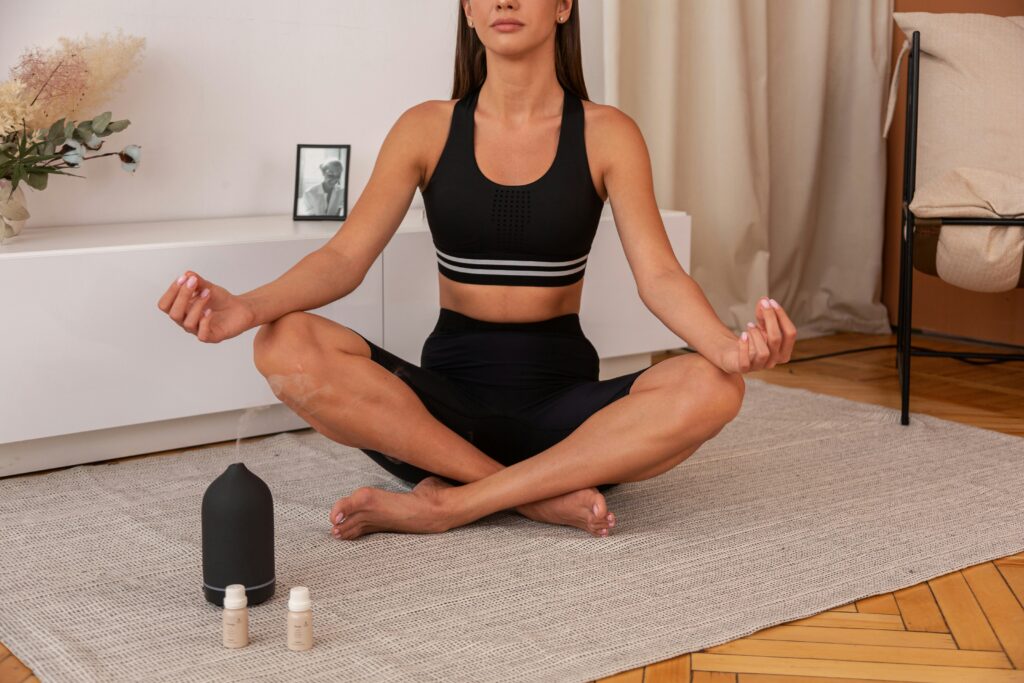Finding moments of calm through the frenetic pace of our lives can be challenging, particularly when the day comes to a close.
Throughout the day, we build up stress through work and day-to-day duties, if neglected, this strain can manifest as restlessness and anxiety, hindering our ability to de-stress.
Often overlooked, but the way we indulge our evenings holds the key to unwinding the daily tension and calming the mind for restorative sleep.
In the evening the world around us slowly starts to settle in, offering moments of introspection and renewal. Within those intervals engaging in evening meditation can offer you a refuge of peace amid life’s tumultuous currents. It doesn’t only count as merely a mindfulness exercise, but a gateway to deep relaxation to shed the weight of the day by delving within.
In this guide, you can explore a collection of evening meditation practices that you can consistently incorporate into your bedtime routine to create a sense of calm and encourage a more restorative sleep experience.
The Role of Evening Meditation in Managing Stress and Anxiety
Incorporating meditation into your day both in the evening and morning offers benefits.
Meditating in the morning can clear fogginess and create cognitive clarity that helps you approach your day with a focused mindset that can increase productivity. By starting your day with morning meditation, you lay the groundwork for a positive day. It initiates the base for emotional stability and attention, enabling us to navigate challenges with greater ease and composure.
While morning meditation is considered the ideal time to make you more focused and bring down the peak cortisol levels, evening meditation is more into helping you unwind after the long hours of work shift and prepare your body for an uninterrupted sleep. Evening meditation can serve as a potent approach to mitigate the effect of stress and anxiety, offering a structured approach to relaxation.
This practice specifically helps to decrease tension and perceived stress levels that have been accumulated throughout the day and fosters a mental and physical calmness that directly alleviates any anxiety and sleep issues.
A 2022 review shows that mindfulness-based stress reduction can significantly reduce anxiety symptoms in young groups of people with long-term intervention.
Another brief study was conducted involving night shift nursing staff who were joined in group mindfulness meditation. Thrice a week the team was called to engage in group practice around midnight for 8 months. The study found that all the participants noticed the favorable outcome of the mindfulness meditation intervention.
The entire team of nursing staff felt a positive impact on their stress level, and focus on work, leading to their improved attitude towards patients.
Although meditating in the mornings and evenings is equally beneficial, evening meditation performs effectively in lowering stress, reducing rumination, and indirectly addressing anxiety symptoms linked to sleep disruption.
Image Credit to Yannic Laderach on Unsplash
10 Evening Meditations to Incorporate into Your Bedtime Routine for Better Sleep
1. Deep Breathing Meditation
Deep breathing meditation is also well-known as diaphragmatic or belly breathing. It is the simplest, most practiced, and yet profound form of meditation that has the intensity to reduce stress and benefit from performing no matter where or when.
- To practice, sit in a comfortable position and place.
- Close your eyes and take a few minutes to relax your body.
- At first, take a few normal breaths to settle into practice, and then slowly bring your focus to each breath you take.
- You can place one hand on your chest and one below your ribs to feel your breath when you inhale and exhale slowly.
- Perform it for at least 10 minutes
There are also different forms of breathing techniques that you can try to manage daily work and life stress.
2. Body Scan Meditation
Body scan meditation is a practice of mindful attention, an approach that involves intentionally moving your awareness through different parts of your body to notice sensations and feelings coursing through your body without any judgments.
- To start with the practice, first, get comfortable by lying down on your back.
- Close your eyes and take a few deep breaths to center yourself and bring your attention inward.
- Start scanning your body, either from the head or toe to notice how each part of your body feels in the moment. Pay attention to your body parts, such as feet, ankles, or knees. Do they feel warm, relaxed, or tense? If so, try flexing or relaxing them
If you find it challenging to keep going, you can try guided body scan meditation to keep you focused.
3. Progressive Muscle Relaxation
Progressive Muscle Relaxation (PMR) is a stress reduction technique that requires you to tighten and then relax each muscle group in your body one after another. Developed by American physician Edmund Jacobson during the 1920s, PMR rests on the concept that physical relaxation can result in mental relaxation.
Similar to body scan meditation, PMR is a relaxation technique that focuses on calming and moving your awareness through all parts of your body, but it differs in approach and emphasis.
Body scan meditation only concerns bringing out attention to your bodily sensations without judgment and the need to change anything by accepting it. Whereas in the PMR technique, you bring your awareness to the stressed muscles to actively tense for a few seconds and then relax, working from toe to head.
Regardless of differences, both techniques share the same goal of inducing a deep state of relaxation and can work well together when stacked into your evening meditation session
4. Mantra Meditation
Mantra meditation is a spiritual form of meditation that includes repeating a word, phrase, or a sound (mantra) like “Om” or “So Hum” to keep your mind focused and attain a state of relaxation and awareness.
This form of meditation has been deeply rooted and widely practiced in Hindu and Buddhist spiritual traditions by monks, but you can practice it in a secular context as well.
To begin, sit in a comfortable position or with your legs crossed in an Indian-style sitting. Close your eyes, take in a few deep breaths to center your mind, and then draw out your mantra while exhaling each breath. When you’re ready to finish your practice, sit quietly for a few minutes and slowly bring yourself back to the present.
Image Credit to Dmitriy Frantsev on Unsplash
5. Mantra Meditation
Better known as walking meditation or mindful movements, this form of meditation gives you the liberty to move your body during practice instead of sitting tight and still experiencing all the renowned benefits of meditation.
In contrast to the traditional approach, the main facet of this practice is meditating in motion. It involves slow and deliberate moves along with bearing focused awareness of your bodily sensation, surroundings, and breath.
Through gentle movements and breath awareness, you can relieve muscle tension and provide a healthy outlet to relieve stress. The rhythmic movements help to shift your focus away from worries and bring it to the present, increasing your focus during practice as well as daily life.
Following are some of the commonly performed forms of movement meditation that you can try out.
1. Walking Meditation:
Find a quiet spot or path where you can walk at a relaxed pace. As you walk, breathe deeply and focus on the feeling in your legs as they move, lift, and make contact with the ground.
2. Qigong:
Originating in China, Qigong is an ancient Chinese practice that combines slow moments, breath control, and meditation to promote your health and martial arts training. The term “qi” refers to the life force or energy that is believed to circulate through our body, and “gong” means cultivation or skill.
Qigong is often practiced as a moving meditation to improve spiritual growth, emotional well-being, and physical health. There are different forms of qigong with their own principle and techniques, but they all share a common focus on acquiring qi for well-being and vitality.
3. Tai Chi:
Qigong is considered to be the foundation of Tai Chi. Both are ancient Chinese practices but qigong has a history spanning thousands of years, while Tai Chi is believed to have originated later around the 17th century.
Tai Chi is a gentle version of martial arts that weaves together steady-flowing moments and mindfulness. Slow and smooth moves that coordinate with each breath can help you elevate daily stress and bring a number of health benefits if incorporated into your daily routine.
You can learn both these practices through classes or basic movements through online tutorials as well.
4. Yoga:
Yoga is an ideal approach to moving meditation that incorporates fitness and meditation benefits. There are many styles and forms of yoga that emphasize the different aspects of your well-being. To enhance your sleep quality, you can introduce a series of poses (asanas) like child’s pose, warrior poses, standing forward bend or corpse pose in your bedtime routine.
5. Dance Meditation:
In dance meditation, you move your body freely and unrehearsed to the rhythm of the music to guide your body and inner sensations. While dancing, you can let go of any self-consciousness and bottled-up emotions and let the beat draw out all the pent-up stress.
6. Gratitude Meditation
Gratitude meditation is a practice that simply focuses on cultivating the mindset to be grateful and appreciate things in our lives. It involves reflecting on things in your day that you are grateful for, which averts your attention away from negative thoughts and emotions.
The major benefit of practicing gratitude meditation is that it takes our heads out of our self-involved enclave and connects to the more mindful and kinder aspect.
You can simply practice this in the morning or settle down for an evening meditation to reflect on the things that you were grateful for. It can be anything from personal relations to people who bring you joy and support, or shifting your focus to the simplest joys in life, like a hearty meal, good books, and moments of joy that fill you with warmth.
7. Candle Gazing Meditation
Candle gazing meditation is also known as Tradaka in Sanskrit and traditional yogic practice. During this practice, you keep your eye focused on a focal point or a candle flame.
To practice, light up a candle and sit comfortably in front of it. Take a few deep breaths to settle yourself while keeping your gaze on the flickering flame of a candle. You can keep looking at it without blinking your eyes as much as possible. If your eyes start to water or feel tired, you can close them for a few moments and then continue the practice as long as you can.
Candle gazing meditation is said to have many health benefits. The amber light of candles promotes warm and soothing effects on you and also stimulates melatonin secretion at night.
It is also believed that it can increase your focus and eyesight by improving blood circulation to the eyes, though there isn’t much research done on it.
Furthermore, this meditation is said to stimulate the Ajna chakra or the “third eye”, which is the center of the institute in the ancient spiritual tradition of experiencing heightened awareness and a deeper connection to inner wisdom.
8. Guided Meditation
Guided meditation is a practice led by an experienced practitioner, audio or video recorder that guides you through a series of relaxation techniques. Guided meditation can be a better alternative if you are planning to make evening meditation a part of your routine.
During the practice, you are prompted to focus on your breath and body and encouraged to release any tension and worry from the day through their guidance to visualization, relaxation techniques, and positive affirmation to promote a sense of calm.
You can learn the guided meditation session through mobile apps, YouTube videos, local classes, or podcasts that are dedicated to meditation.
Image Credit to JD Mason on Unsplash
9. Silent Meditation
Silent meditation is a foundational practice in many spiritual traditions, like Buddhism, Hinduism, and Taoism. It is a still or quiet meditation that involves you sitting quietly and bringing your focus inward.
Unlike guided meditation and other forms of meditation that require any inward or external engagement, silent meditation is done with complete silence, letting your breath flow in and out naturally.
Including this form of meditation in your evening meditation session or bedtime routine can restore a profound impact on your spiritual growth and self-acceptance. Practicing it daily without changing and suppressing your emotions can help you accept your thoughts and yourself as they are, helping you live harmoniously with the world around you.
10. Yoga Nidra (NSDR)
Yoga Nidra, or Non-Sleep Dep Rest (NSDR), is believed to have been introduced by Swami Satyananda Saraswati, the founder of the Bihar School of Yoga in India. Yoga Nidra has since become popular recently by Andrew Huberman, an American Neuroscientist and podcaster.
Similar to yoga corpse pose or Savasana you are in a reclining position but guided through scripts and instructions like guided meditation.
During yoga nidra, you remain in a state between wakefulness and sleep, but not sleeping, somewhat in an illusory state, where you completely calm your body and mind, which leads you to deep relaxation but brings heightened awareness.
A 30-minute session of NSDR can organize your stream of thoughts and bring down the cortisol level, which is considered the best practice to perform when you are stressed from your daily work.
To perform, lie down comfortably on your bed or any comfy spot. Get your body into a relaxed position by placing your hands by your side and your legs loosened. Mentally set an intention for a specific goal or simply a desire for deep relaxation. You can find an NSDR script online or videos to keep you guided through the practice. Through the instruction follow your breath and visualization to release tension and deeply unwind.
7 Ways to Establish an Evening Meditation Routine for Better Sleep
Practicing evening meditation is a great way to unwind after a long stressful day and create a bedtime routine that fosters more peaceful sleep. Here are a few effective ways to incorporate meditation habits into your evening routine and make it an everyday ritual.
1. Set a Consistent Schedule
To start and stay committed to any practice, settling on a specific regular time is the key. Pick a time to practice meditation that you can easily devote to, whether it’s right before your bedtime or earlier in the evening. Sticking to a consistent schedule will habituate your body to seek out calming practice and prepare you to relax for sleep.
Image Credit to Mathilde Langevin on Unsplash
2. Create a Healing Harbor
When you meditate, you engage all your senses, so it is important to form an atmosphere that is conducive to it. Making a relaxing mood while meditating has an important role in unwinding and eliciting calming mental and bodily responses.
Choose a quiet and comfortable space for yourself where you can practice your evening meditation session without interruption. To set the mood, dim the lights or use candles, string lights, or Himalayan salt lamps to add ambiance. Play nature sounds in the background and diffuse a soothing blend of essential oils. And if possible, place some indoor plants into your space to bring in nature elements.
3. Start Small
Meditation is a practice that grows with consistency. Like any other skill, it requires devoting time and dedication to see the expected results.
To remain persistent, initially aim for short and manageable sessions like five or ten minutes, allowing you to get accustomed and gradually build your meditation skills. Consistently showing up for the practice will build your resilience and your commitment to self-care as well.
4. Use Guided Meditation
When you are just starting, sitting still and keeping your thoughts in check seems the most challenging. So, if you are struggling to rein in your Haywire thoughts, starting with guided meditation can give you a base to anchor them.
Guided meditation videos or apps are specifically created to guide you through your practice, hence keeping you in the practice and promoting relaxation.
5. Set Intentions for Healing and Relaxation
Before starting your practice, clarify your intentions. Distill them into your every meditation session with a clear and concise intention and a mindset like “I intend to promote relaxation and calmness within” or “I intend to bring calmness and healing through my practice.”
Close your eyes and visualize you are already in that state where you are surrounded by peacefulness and healing.
6. Combine Meditation With Other Activities
Blending your evening meditation with your daily rituals or other everyday activities can enhance relaxation and productivity.
Beginning with a brief session can help you ease into the practice more comfortably. For example, after dinner every evening, you can take a 5-10-minute mindful evening stroll to simply focus on your breathing and steps or incorporate it into any routine task like eating or doing dishes to allow these mundane chores to become meditative experiences themselves.
7. Try Theme Based Meditation
Theme-based meditation involves concentrating on a particular concept or theme, like a purpose or emotion, instead of solely focusing on your bodily and breathing sensations.
While meditating, you direct your attention to a reflection which can be any expressions or visualization that lines up with your need and intention, like gratitude, compassion, and self-love, or any other reflections you wish to explore.
Improve Your Sleep and Well-Being Through Evening Meditation
Incorporating evening meditation practices into your bedtime routine, whether you prefer deep breathing exercises, body scanning, or guided meditation, can decrease your response to stressors. So, take time to engage in practice that resonates with you, which can help you improve your sleep and holistic health further.





